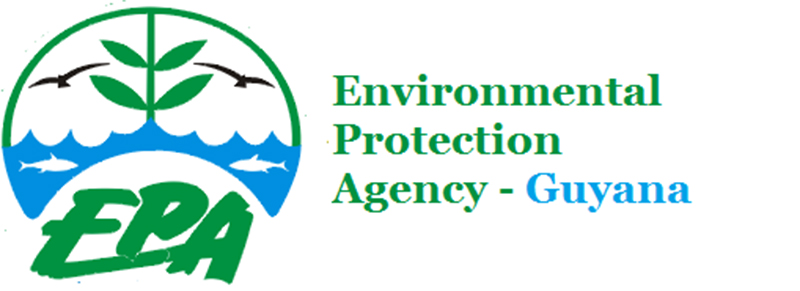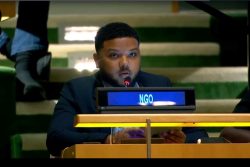Amid heightened scrutiny and criticism of its conduct, the Envi-ronmental Protection Agency (EPA) yesterday said it was strengthening its processes and adherence to the Act governing it.
In a lengthy release on what it is doing to fulfil its mandate, the EPA asserted that it has been “improving its internal decision-making to ensure it best serves its mandate of protecting the environment and managing the sustainable use of Guyana’s natural resources.” It noted that there has been an influx of new unfamiliar projects which are directly correlated to the rapid growth of the oil and gas sector. Also noted was the increased scrutiny that its work has come under recently which it acknowledged was understandable given that its motto is ‘The Environment is Everybody’s Business’. It has not escaped the Agency that such scrutiny has become more strident of late and while it does recognise its deficiencies, it asks the public to appreciate that “these are not situations that developed overnight.”
Subsequently, the EPA stated that it is reviewing its processes and in concert with the appointment of its new Executive Director, and has taken a more “aggressive and proactive approach” to best fulfill its mandate.
EPA decisions not to require Environmental Impact Assessments for major projects like the new bridge over the Demerara River and ExxonMobil’s exploration ventures have attracted widespread condemnation.
According to the Agency, it has adopted a number of measures to fulfil its mandate. They include strengthened requirements for Project Summaries which must be submitted by the developers applying for environmental authorisation. It explain-ed that these summaries must include the likely impacts of, and mitigation measures that would be used by the developer. Section 11 (10) of the Environmental Protection (EP) Act, it says, stipulates that the Project Summary should include information relative to the site, design, and size of the project; possible effects on the environment; duration of the project; and a non-technical explanation.
The Agency noted that it has developed a comprehensive Project Summary Guideline for developers and applicants to ensure firstly, that the requirements of the Act are met, and secondly, to inform its decision and provide the public with pertinent information. The information required, it explained, must include, but is not limited to baseline assessment and evidence of stakeholder consultations/meetings on the proposed project and a decommissioning plan where applicable.
Further, it was pointed out that each application for an Environ-mental Authorisation… oil and gas related or not, undergoes a “meticulous” process referred to as screening which is the first stage of the environmental assessment process. It is the stage where the decision is made as to whether an Environmental Impact Assessment (EIA) is required or not. Section 11 (2) of the Act provides for this process and empowers the Agency to make one of two decisions when assessing an application. Either the project will significantly affect the environment and therefore will require the conduct of an EIA, or that a project will not significantly affect the environment so that an EIA is not required. The release stressed that it is at this point where the EPA’s concern is the “significance of the impacts on the environment.”
The Agency also informed that it has strengthened its screening process by ensuring appropriate questions are asked of the proposed project, site visits are conducted, existing information is gathered and reviewed, and engagement with key agencies and residents in the area of the proposed project is done. And the outcome of this process, it stated, is a screening report on the potential impacts and identification of possible significant impacts to inform the Agency’s decision with regard to whether or not an EIA is required so as to further inform its decision to issue an Environmental Permit or not. Also strengthened is the Agency’s adherence to the Act by publishing reasons for its decisions and making Project Summaries available for public access and review.
In addition, the EPA is retroactively scrutinising existing activities with these now being subject to Section 11 (1) and (2) of the Act. These projects, it noted, which have been operating for a number of years and not authorised are also being screened to determine if there is potential for legacy and continued significant impacts, and decisions with screening reports published in accordance with Section 11 (2) of the Act.
A key function of the Agency’s mandate is to make available to the public, a register of information as set out in Section 3(e) and 36 (1) and (7) which it assures it intends to fulfill. However, while the Act does require a register, The EPA admitted that the volume of information is “insurmountable,” and thus it is difficult to compile a register per se. To offset this hurdle, all requests for information are handled by the Communications Department, and are screened to ensure the requested information meets the requirement of the Act and subsequently fulfilled. This is seen as a key area of improvement and ensuring transparency and providing information to the public regarding the decisions of the Agency, and nature and level of compliance of projects being authorised. Further, the Agency stated that it is in the process of making this information available online via a public query system where any member of the public can check on status of the application for Environmental Authorization and/or compliance of a particular facility.
And in recognition of the fact that there may be gaps in the interpretation of the Environmental Protection Act, the Agency is seeking legal advice while undertaking appropriate adjustments to its processes and procedures based on said legal guidance.
Strengthened compliance and enforcement of permitted facilities
The release explained that each project is assessed and placed on a compliance schedule based on the level of risk. In addition to self-monitoring as required by the permit holders, the Agency also conducts routine compliance inspections and may administer various penalties in accordance with the anti-pollution regulations where breaches are found.
The Agency informed that it has established a Complaints and Emergency Response Program-me Area which allows it to aggressively address environmental complaints in a more efficient manner. In this regard, a Complaints Strategy was developed which assesses each complaint, identifies the hotspots, and crafts appropriate interventions including capacity building for some categories of stakeholders.
It was also disclosed that there is a backlog of over 2,500 complaints relating to residential and domestic issues regarding which the Agency is currently collaborating with the Ministry of Local Government and Regional Development to engage the local organs in addressing these matters. It pointed out that while the Regional Development Councils (RDC) and the Neighbourhood Democratic Councils (NDC) are mandated by law to deal with localised complaints, lack of resources, training, and political influence in the past were cited as main hindrances in resolving these complaints. “It is the intention of the EPA to provide support with regards to prosecution and delegation of its functions, while at the same providing capacity building to local authorities on steps to manage and resolve complaints.”
Regarding the issue of noise nuisance, the Agency stated that it has met with the Guyana Police Force to coordinate efforts to tackle this issue, and the Mayor and City Council (M&CC) to address littering in the capital city. Meanwhile, the Complaints Department has also been meeting with complainants and defaulters in an attempt to arrive at some compromise in light of several issues including zoning and approvals from the relevant authorities – NDCs and Central Housing & Planning Authority (CH&PA).
Emergency Response
As it pertains to emergency responses, the Complaints Department with support from the Health and Safety Specialist has crafted an Emergency Response Roster for staff of the Agency to respond to any emergency that may occur. The Agency informed that it has been responding to incidents from natural, technological or human-induced factors, or a combination of these, that may cause or has caused severe environmental damage as well as harm to human health and/or livelihoods. It plans to strengthen its efforts to collaborate with other agencies on early detection of these incidents and the use of GIS/Remote sensing technologies to improve monitoring and reporting.
Strengthened monitoring capabilities
The EPA disclosed that it will soon launch a remote real-time monitoring system and platform to monitor permitted facilities and level of compliance with key environmental parameters. This is being done by via a combination of acquisition of satellite services, installation of sensors for air quality index, and other environmental parameters.
It is also in the process of bolstering its monitoring and assessment capability by procuring modern and state of the art measurement equipment/instruments and analyses tools to take accurate measurements, and to make credible assessments of impacts of pollutants in air, water and land. This, it notes, is a basic capability of any environmental regulatory agency for providing “trustworthy and timely” assessments of risks and corrective actions. The Agency currently utilises drone technology and has amplified the use of GIS and other digital technology for remote monitoring.
Capacity building
The EPA’s staff attend virtual webinars which are facilitated through international and local partnerships. To date, it informs, 81 persons have participated in virtual webinars focussed on areas such as risk assessment and risk management, climate change and climate mitigation, human rights in Environmental Impact Assessments, reducing emission and air quality impacts, and building resilience for oil producers. Additionally, the Agency stated that it is working closely with the Ministry of Local Government, specifically the local organs, to address the pollution issues within the communities.
It was also emphasised that capacity building remains a core component of the Agency of the work and this includes building the technical capacity of its staff to execute its mandate, as well as building the capacity of developers and stakeholders to understand their responsibilities. The Agency pointed out that to date it has:
● established a Training Unit within the Human Resources Department
● conducted capacity building with the Guyana Police Force to manage noise complaints
● conducted awareness sessions with private sector bodies on EPA’s processes and procedures · coordinated
● capacity building workshops for Neighbourhood Democratic Councils to effectively investigate and resolve environmental complaints.
The EPA stated that it is cognizant of the importance of public participation in the preparatory stages of projects that may impact residents. Additionally, it also publishes notices of proposed projects along with the Project Summaries, and provides forums for public engagement. It also recognises that “no organization is perfect,” and ensures that management “periodically assesses and evaluates the effectiveness of efforts undertaken, and consistently explores ways to improve operations and meet its mandate,” the release added.









